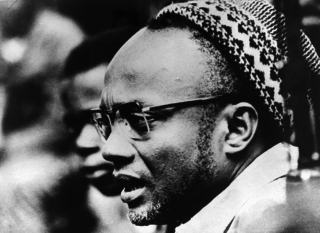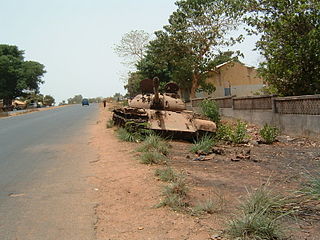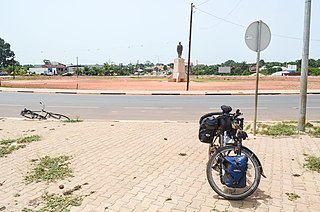
Guinea-Bissau, officially the Republic of Guinea-Bissau, is a country in West Africa that covers 36,125 square kilometres (13,948 sq mi) with an estimated population of 2,026,778. It borders Senegal to its north and Guinea to its southeast.

Transport infrastructure in Guinea-Bissau is basic, with most roads outside the capital Bissau being unpaved.

Bissau is the capital and largest city of Guinea-Bissau. As of 2015, it had a population of 492,004. Bissau is located on the Geba River estuary, off the Atlantic Ocean, and is Guinea-Bissau's largest city, major port, its administrative and military center.

Aristides Maria Pereira was a Cape Verdean politician. He was the first President of Cape Verde, serving from 1975 to 1991.

Amílcar Lopes Cabral was a Bissau-Guinean and Cape Verdean agricultural engineer, political organizer, and diplomat. He was one of Africa's foremost anti-colonial leaders. He was also a pan-Africanist and intellectual nationalist revolutionary poet.

Osvaldo Vieira International Airport, also known as Bissau-Bissalanca Airport, is an international airport that serves the city of Bissau, the capital of Guinea-Bissau, as well as the Metropolitan Region of Bissau. It is the only international airport in the country.

The Guinea-Bissau Civil War was fought from 7 June 1998 to 10 May 1999 and was triggered by an attempted coup d'état against the government of President João Bernardo Vieira led by Brigadier-General Ansumane Mané. Government forces, backed by neighbouring states, clashed with the coup leaders who had quickly gained almost total control over the country's armed forces.

EuroAtlantic Airways, legally EuroAtlantic Airways – Transportes Aéreos S.A., is a Portuguese Charter ACMI airline specialized in leasing and air charter headquartered in Carnaxide and based at Lisbon Airport.

Safim is a city and sector in the Biombo Region of Guinea-Bissau. It has a population of 17,356 inhabitants as of the 2009 national census.
Instituto Piaget is a Portuguese private institution of higher education. It provides both university and polytechnic higher education in a number of fields. Instituto Piaget was named after the Swiss philosopher and developmental psychologist Jean Piaget.

The following outline is provided as an overview of and topical guide to Guinea-Bissau:

The official language of Guinea-Bissau is Portuguese, which was spoken by 32.1% of the population according to the 2009 census. It is the language of instruction in schools, the language of literary production, the written press, legislation and administration.
Balanta is a group of two closely related Bak languages of West Africa spoken by the Balanta people.
The Universidade Colinas de Boé (UCB) is a private institution of higher education in Guinea-Bissau. It was founded in September 2003 and the first university in Guinea-Bissau, just before the creation of the Universidade Amílcar Cabral, the only public university in the country. In 2007, it established a cooperation agreement with the Polytechnic Institute of Leiria (IPL).

The Biblioteca Pública do INEP is the national library of Guinea-Bissau and it is located in Bissau. It is also the biggest public library in the country and serves as library of the Universidade Amílcar Cabral.
Maria Odete da Costa Semedo is a writer and educator from Guinea-Bissau. She works in both in Portuguese and Guinea Creole.
Bissau is a city in Guinea-Bissau, a country in West Africa, formerly part of the kingdom of Kaabu and part of the Mali Empire.
The National Lyceum Kwame N'Krumah is a Bissau-Guinean educational institution, based in Bissau, the country's capital.